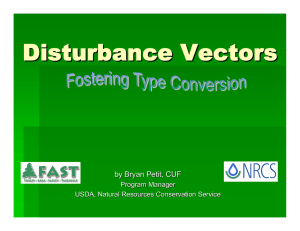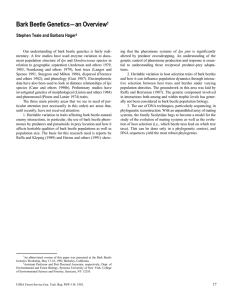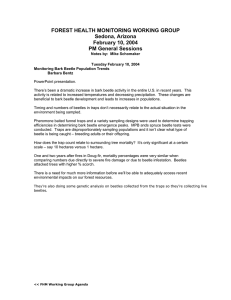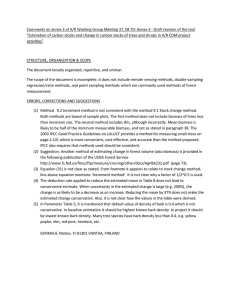THE HISTORICAL ROLE OF CURCULIONIDAE) IN THE SPRUCE FOREST OF ILE
advertisement
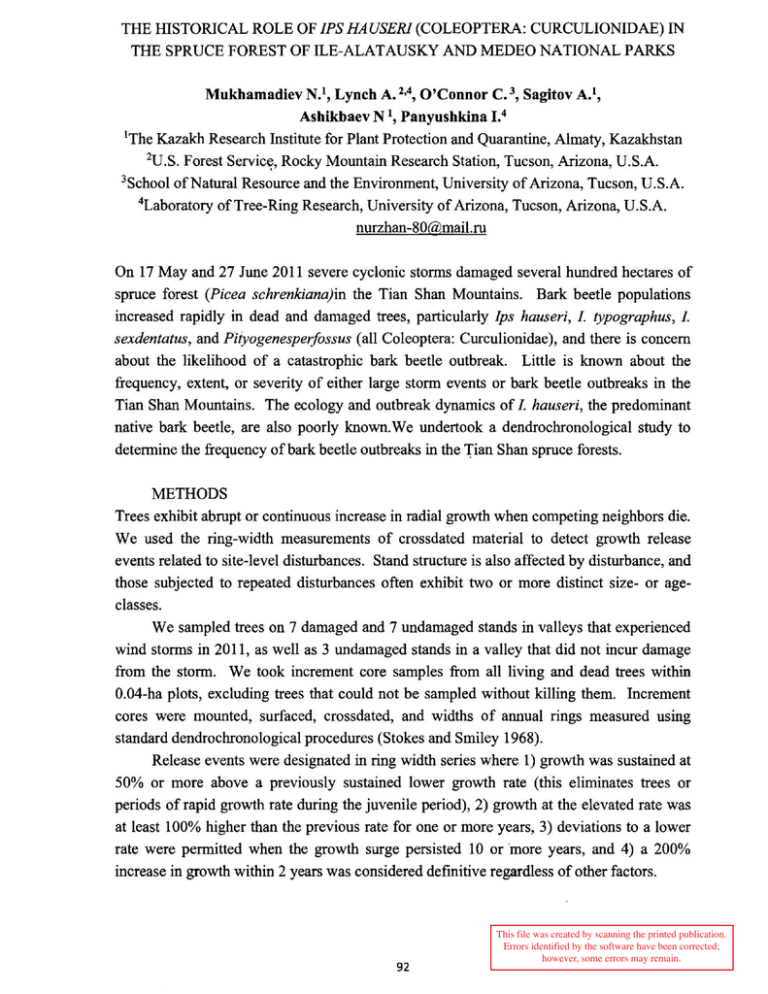
THE HISTORICAL ROLE OF JPS HA USERI (COLEOPTERA: CURCULIONIDAE) IN THE SPRUCE FOREST OF ILE-ALATAUSKY AND MEDEO NATIONAL PARKS Mukhamadiev N. 1, Lynch A. 2.4, O'Connor C. 3, Sagitov A. 1, Ashikbaev N 1, Panyushkina I.4 1 The Kazakh Research Institute for Plant Protection and Quarantine, Almaty, Kazakhstan 2 U.S. Forest Servic~, Rocky Mountain Research Station, Tucson, Arizona, U.S.A. 3 School of Natural Resource and the Environment, University of Arizona, Tucson, U.S.A. 4 Laboratory of Tree-Ring Research, University of Arizona, Tucson, Arizona, U.S.A. nurzhan-80@mail.ru On 17 May and 27 June 2011 severe cyclonic storms damaged several hundred hectares of spruce forest (Picea schrenkiana)in the Tian Shan Mountains. Bark beetle populations increased rapidly in dead and damaged trees, particularly fps hauseri, I. typographus, I. sexdentatus, and Piiyogenesperfossus (all Coleoptera: Curculionidae), and there is concern about the likelihood of a catastrophic bark beetle outbreak. Little is known about the frequency, extent, or severity of either large storm events or bark beetle outbreaks in the Tian Shan Mountains. The ecology and outbreak dynamics of I. hauseri, the predominant native bark beetle, are also poorly known. We undertook a dendrochronological study to determine the frequency of bark beetle outbreaks in the Tian Shan spruce forests. METHODS Trees exhibit abrupt or continuous increase in radial growth when competing neighbors die. We used the ring-width measurements of crossdated material to detect growth release events related to site-level disturbances. Stand structure is also affected by disturbance, and those subjected to repeated disturbances often exhibit two or more distinct size- or ageclasses. We sampled trees on 7 damaged and 7 undamaged stands in valleys that experienced wind storms in 2011, as well as 3 undamaged stands in a valley that did not incur damage from the storm. We took increment core samples from all living and dead trees within 0.04-ha plots, excluding trees that could not be sampled without killing them. Increment cores were mounted, surfaced, crossdated, and widths of arumal rings measured using standard dendrochronological procedures (Stokes and Smiley 1968). Release events were designated in ring width series where 1) growth was sustained at 50% or more above a previously sustained lower growth rate (this eliminates trees or periods of rapid growth rate during the juvenile period), 2) growth at the elevated rate was at least 100% higher than the previous rate for one or more years, 3) deviations to a lower rate were permitted when the growth surge persisted 10 or ·more years, and 4) a 200% increase in growth within 2 years was considered definitive regardless of other factors. 92 This file was created by scanning the printed publication. Errors identified by the software have been corrected; however, some errors may remain. RESULTS We reconstructed a nearly 200-year history of disturbances in the Tien Shan spruce forest and found no evidence of an extensive bark beetle outbreak within that time frame. Growth releases were of local scale, and were only infrequently temporally coincidental on more than one plot. Within individual plots, growth releases were temporally clustered but not synchronous - different trees would exhibit releases over a 4- to 6-year period. Trees respond to environmental chan&e at different rates depending on their initial health, severity of suppression, and the nature of environmental change, but the extended nature of these release events is indicative of an initial disturbance followed by a localized bark beetle outbreak in which the first damaged trees are colonized by bark beetles which go on to attack nearby trees in subsequent years.Only two or three stands exhibited distinct age-class distributions indicative of past severe disturbance. Collectively, this evidence indicates that the primary historical disturbance agent in the Tien Shan spruce forest has functioned at the local scale, with bark beetles acting as a secondary disturbance agent at a similar scale. Most likely damage from avalanches and rock slides is the initial source of bark beetle host material, and extensive severe outbreaks have not developed. Sites damaged in the 2011 wind storms were found on similar elevations, aspect, and slope steepness compared to non-damaged sites. However, trees on those sites were significantly larger and tree density was somewhat lower (mean dbh 57 vs 38 cm, sig. = 0.06; no. trees per ha 229 vs 302, sig. = 0.15). Sites damaged in 2011 had a history of fewer disturbances than did non-damaged sites (Fig. 1). Damaged In 2011 1 tll No damaged In 2011 .... .. --;.._ =l m ..~ lL _ L_J_tl J. Figure I.Composite records of historical disturbance dates in sites damaged in the 2011 wind storm events, compared to sites not damaged in the storms. Each line represents a growth release detected in one or more sites for that year. It should be noted that this methodology does not precisely date the disturbance events, but dates the tree response to those disturbances. Usually that is within one year, but response is not always abrupt, and initial radial growth response cannot always be readily distinguished from normal year-to-year growth variability. 93 DISCUSSION We found no evidence of earlier extensive severe bark beetle outbreaks. I. hauseri is capable of rapid population buildup in P. schrenkiana during drought (Prutenskii and Romanenko (1954), but its biology and ecology are poorly known. Populations can respond rapidly to drought, with mortality approaching 50% on south-facing slopes (Prutenskii and Romanenko 1954). But populations decline when precipitation recovers (Prutenskii and Romanenko 1954). However, outbreaks of I. typographusalso develop in storm-damaged timber and once underway can continue to develop in healthy forests (Wermelinger 2004). Outbreaks can take a few years to develop and persist for a decade (Ohm 2012)./. typographus is considered to be the most serious forest pest in Europe (Ohm 2012), so its establishment in the Tien Shan Mountains is worrisome. Our reconstruction indicates that I. hauseri has not had a severe outbreak in approximately the last 200 years, but I. typographus was presumably absent. Aggressive sanitation of storm-damaged timber and infested trees might reduce the likelihood of these species developing outbreaks. It is difficult to deduce with certainty from our data why the spruce forest is relatively young. P. schrenkiana is capable of attaining >500 years (Wu et al. 2013). We found trees in three locations that were older than what is presented here. Two sites were near streams and all of the obviously ancient older trees were not usable due to stem decay. The other site contained too few trees for our purpose. We think that stem decay is the primary reason that few spruce in our samples were older than 200 years, but we cannot rule out the possibility of a severe bark beetle outbreak or other possible factors in the 1700s. Canopy height and stand density may have contributed to blowdown severity.On average, sites that were damaged in 2011 had a lower frequency of prior disturbance than sites with damage in 2011 (Fig. 1), and were occupied by fewer but larger trees. Because the release events were not synchronous amongst stands, they do not correlate with known earthquake dates. REFERENCES 1. Ohm P. 2012. The spruce bark beetle fps typographus in a changing climate Effects of weather conditions on the biology of fps typographus. Introductory Research Essay No. 18, Department of Ecology, Swedish University of Agricultural Sciences. Uppsala. 27 p. 2. Prutenskii D., Romanenko K. 1954. fps hauseri: It's role and importance for the death of forests of Picea schrenkiana and Pinussylvestris in Kirgizia. pp. 177-191 in Proceedings of the Institute of Botany & Plant Industry, Vol. l.izdatel'stvoKirgizskogoOtdeleniyaAkademiiNauk SSSR, Frunze (KG). In Russian. 3. Wermelinger B. 2004. Ecology and management of the spruce bark beetle fps typographus - a review of recent research. Forest Ecology and Management 202: 67-82. 4. Wu G., Xu G., Chen T., Liu X., Zhang Y., An W., Wang W., Fang Z-a., Yu S. 2013. Age-dependent tree-ring growth responses of Schrenk spruce (Picea schrenkiana) to climate - A case study in the Tianshan Mountain, China. Dendrochronologia 31: 318-326. 94

